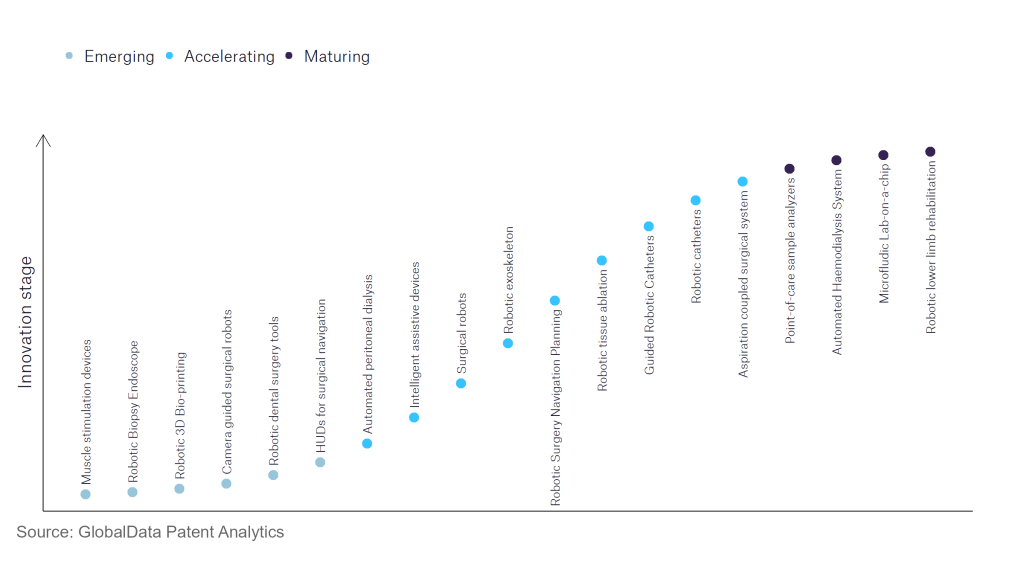<!–
–>
The medical devices industry continues to be a hotbed of innovation, with activity driven by increased need for homecare, preventative treatments, early diagnosis, reducing patient recovery times and improving outcomes, as well as a growing importance in technologies, such as machine learning, augmented reality, 5G and digitalization. In the last three years alone, there have been over 450,000 patents filed and granted in the medical devices industry, according to GlobalData’s report on Robotics in Medical Devices: Intelligent assistive devices.
However, not all innovations are equal and nor do they follow a constant upward trend. Instead, their evolution takes the form of an S-shaped curve that reflects their typical lifecycle from early emergence to accelerating adoption, before finally stabilising and reaching maturity.
Identifying where a particular innovation is on this journey, especially those that are in the emerging and accelerating stages, is essential for understanding their current level of adoption and the likely future trajectory and impact they will have.
150+ innovations will shape the medical devices industry
According to GlobalData’s Technology Foresights, which plots the S-curve for the medical devices industry using innovation intensity models built on over 550,000 patents, there are 150+ innovation areas that will shape the future of the industry.
Within the emerging innovation stage, HUDs for surgical navigation, robotic biopsy endoscope and camera-guided surgical robots are disruptive technologies that are in the early stages of application and should be tracked closely. Robotic exoskeleton, surgical robots, and robotic catheters are some of the accelerating innovation areas, where adoption has been steadily increasing. Among maturing innovation areas are robotic lower limb rehabilitation and microfluidic lab-on-a-chip, which are now well established in the industry.
Innovation S-curve for robotics in the medical devices industry

Intelligent assistive devices is a key innovation area in robotics
Assistive devices include mobility aids, such as walkers, wheelchairs and crutches, equipped with sensors to notify users in dangerous situations and to communicate with others in the case of a fall, among other things. Incorporating intelligent assistive devices into eldercare may offer opportunities to reduce caregiver burden and improve healthcare services while improving the quality of life among older adults with mild to severe cognitive deficits.
GlobalData’s analysis also uncovers the companies at the forefront of each innovation area and assesses the potential reach and impact of their patenting activity across different applications and geographies. According to GlobalData, there are 50+ companies, spanning technology vendors, established medical devices companies, and up-and-coming start-ups engaged in the development and application of intelligent assistive devices.
Key players in intelligent assistive devices – a disruptive innovation in the medical devices industry
Application diversity’ measures the number of different applications identified for each relevant patent and broadly splits companies into either ‘niche’ or ‘diversified’ innovators.
‘Geographic reach’ refers to the number of different countries each relevant patent is registered in and reflects the breadth of geographic application intended, ranging from ‘global’ to ‘local’.
Patent volumes related to intelligent assistive devices
Source: GlobalData Patent Analytics
Samsung Group and Toyota Motor are two of the leading patent filers in intelligent assistive devices. Some other leading patent filers include Panasonic, Murata Manufacturing, Evolution Technologies, NC, Funai Electric, Beijing Electronics Holding, Wistron, and LG.
In terms of application diversity, Baxter International leads the pack, followed by WearWorks and Toray Industries. With regards to geographic reach, EW Healthcare Partners holds the top position, followed by Space Bio-Laboratories and Fujikura in the second and third spots, respectively.
A considerable percentage of caregivers and older individuals lack access to intelligent assistive technologies (IAT) due to a variety of issues, including socioeconomic position, technology literacy, and the ongoing digital divide. Existing and upcoming IATs for caregivers and care recipients must be evaluated for their potential to benefit the overall target group.
To further understand how robotics is disrupting the medical devices industry, access GlobalData’s latest thematic research report on Robotics in Medical (2021).
- SEO Powered Content & PR Distribution. Get Amplified Today.
- Platoblockchain. Web3 Metaverse Intelligence. Knowledge Amplified. Access Here.
- Source: https://www.medicaldevice-network.com/data-insights/innovators-robotics-intelligent-assistive-devices-medical-devices/



